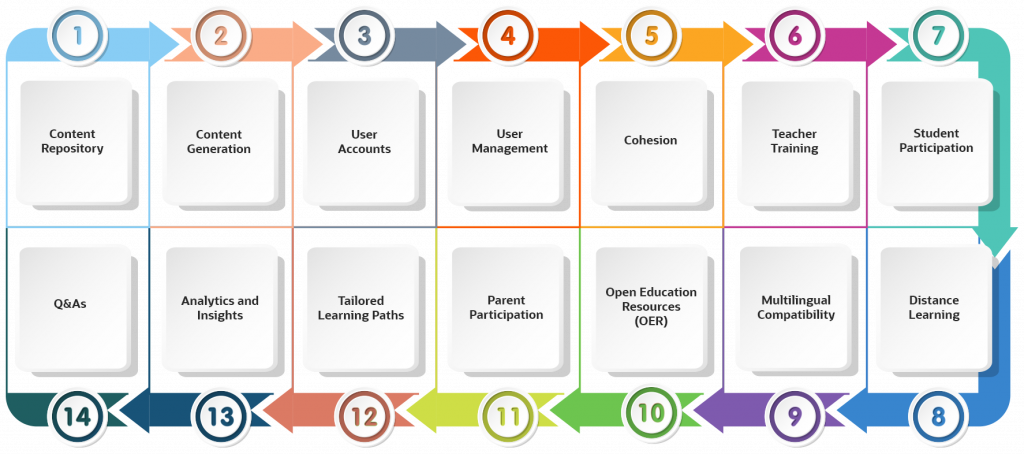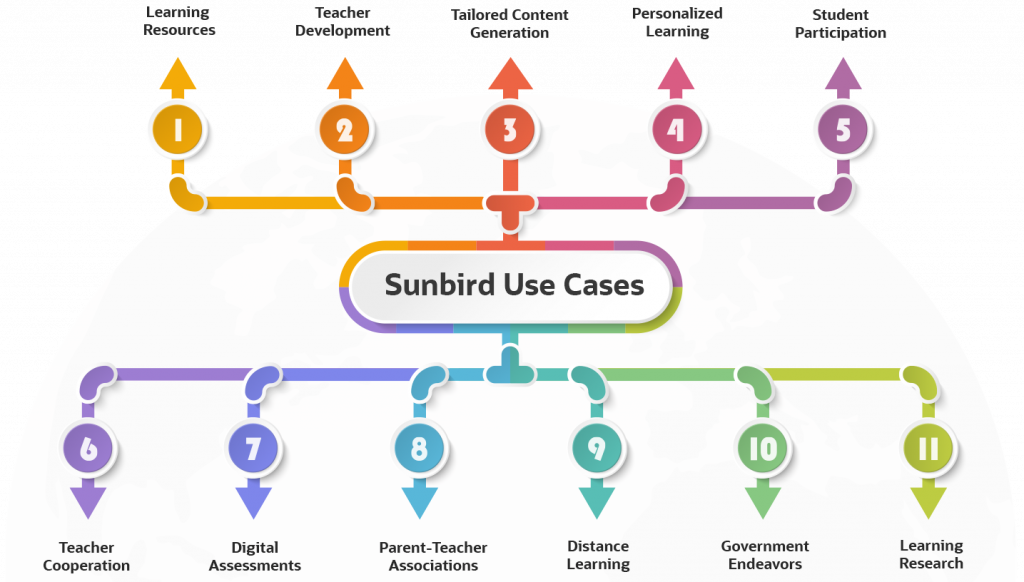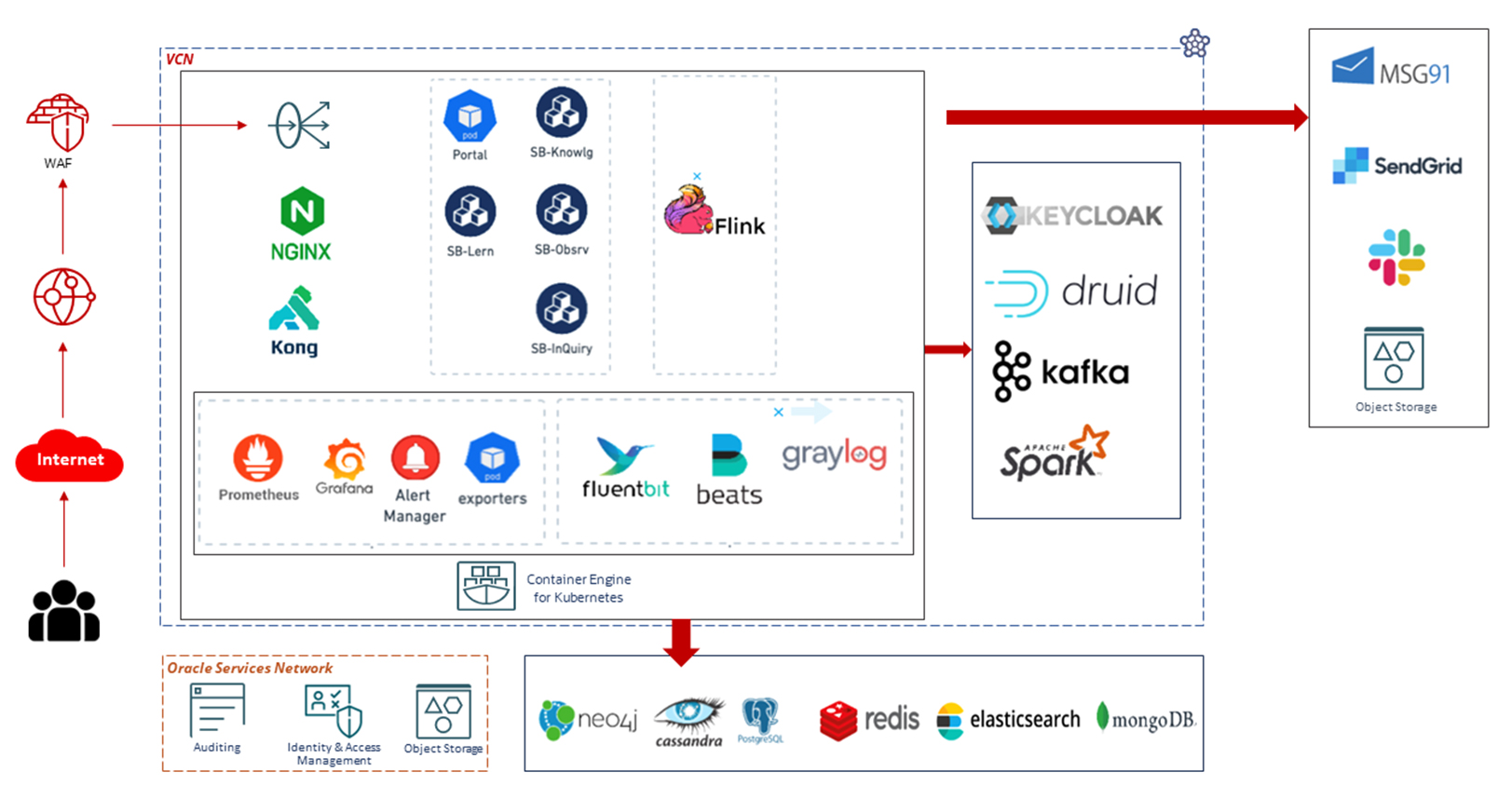Traditional learning methods and training approaches are undergoing significant transformations, breaking down barriers and fostering efficiency. And Sunbird is one of the pioneers of the phenomenon. From their open-source platform to QR codes, digital training, micro-improvements, OCR-plus solutions, and Insights Hub – each piece of their innovation plays a cardinal role in developing customized and scalable learning and human development platforms. Let us have a quick overview of the Sunbird applications’ unfurling impact, followed by how Oracle Cloud Infrastructure (OCI) is supporting the initiative.
What is Sunbird? A Business Overview
Sunbird software is a beacon of innovation in education, developed by the EkStep foundation and supported by the Indian Government’s National Council of Educational Research and Training (NCERT). This open-source platform empowers teachers and educators by providing them with a versatile toolset for creating, sharing, and distributing digital educational content. Sunbird goes beyond traditional content delivery, offering a spectrum of features designed to enhance the teaching and learning experience.
Sunbird’s Differentiators

-
1. Content Repository:
Sunbird offers a vast repository of digital educational content, including e-books, videos, interactive lessons, and more. Educators can easily access materials that align with their curriculum, breaking down geographical barriers to knowledge.
-
2. Content Generation:
Empowering educators to craft and publish their own digital content, Sunbird supports personalized and engaging learning experiences. Lesson plans, quizzes, assignments, and interactive activities come to life with this feature.
-
3. User Accounts:
Sunbird encourages users, including educators and students, to create comprehensive profiles, fostering a sense of community and collaboration. These profiles showcase educational backgrounds, interests, and achievements.
-
4. User Management:
Administrators can exercise precise control over user accounts, roles, and permissions, ensuring secure and appropriate access to resources.
-
5. Cohesion:
Sunbird facilitates collaboration among educators, enabling them to share best practices, lesson plans, and teaching strategies. A supportive community of teachers emerges, creating a continuous learning environment.
-
6. Teacher Training:
Sunbird offers professional development opportunities for educators through online courses, workshops, and resources, enhancing teaching skills and staying current with educational trends.
-
7. Student Participation:
With interactive content and multimedia resources, Sunbird significantly enhances student engagement, making learning a dynamic and enjoyable experience.
-
8. Q&As:
Sunbird supports the creation and administration of quizzes and assessments, providing educators with essential tools to evaluate student understanding effectively.
-
9. Analytics and Insights:
The platform offers data-driven insights into content usage, engagement, and learning outcomes. Educators can make informed decisions to tailor their teaching strategies.
-
10. Tailored Learning Paths:
Educators can design personalized learning paths for students, adapting content based on individual needs and learning styles, promoting more effective learning outcomes.
-
11. Parent Participation:
Sunbird facilitates transparent communication between parents and teachers, enabling parents to monitor their child's progress, assignments, and engagement with the platform.
-
12. Open Education Resources (OER):
Sunbird supports the use and sharing of open educational resources, making high-quality educational content accessible to a broader audience, thereby democratizing education.
-
13. Multilingual Compatibility:
The platform's multilingual support ensures accessibility for diverse user groups, breaking language barriers and promoting inclusivity.
-
14. Distance Learning:
Sunbird's digital nature makes it ideally suited for remote and distance learning scenarios, enabling students to access educational materials securely from their homes.
Sunbird Use Cases

-
1. Online Learning Resources:
Sunbird offers access to a diverse range of digital learning resources, including e-books, videos, audio content, lesson plans, and more. Educators can leverage these resources to enhance their teaching materials.
-
2. Teacher Development:
Sunbird serves as a powerful tool for teacher training and professional development, offering flexible, device-agnostic access to expert-delivered training.
-
3. Tailored Content Generation:
Educators can harness Sunbird's content creation tools to develop custom learning resources tailored to their students' needs and curriculum requirements.
-
4. Personalized Learning:
Sunbird supports personalized learning by enabling educators to create differentiated learning paths for students based on their abilities, interests, and learning styles.
-
5. Student Participation:
Interactive and multimedia-rich content enhances student engagement significantly.
-
6. Teacher Cooperation:
Sunbird fosters collaboration among educators by providing a dedicated platform for sharing best practices, lesson plans, and teaching strategies.
-
7. Digital Assessments:
Educators can seamlessly create and administer online assessments, quizzes, and tests through Sunbird.
-
8. Parent-Teacher Associations:
Sunbird bridges the gap between parents and teachers by facilitating transparent communication.
-
9. Distance Learning:
Sunbird's digital resources and tools are invaluable for remote and distance learning scenarios.
-
10. Government Endeavors:
Sunbird aligns seamlessly with government initiatives aimed at elevating the quality of education.
-
11. Learning Research:
Researchers and policymakers can harness Sunbird's extensive data and insights to analyze trends in educational content usage, learning outcomes, and teaching methods.
Bridging the Physical-Digital Divide with QR Codes
In traditional learning methods, physical resources like books and training materials often remain isolated from the vast digital resources available online, resulting in fragmented learning experiences. The solution? QR codes that dynamically link to digital resources, creating a seamless connection between physical and digital learning materials.
Implementation in DIKSHA:
DIKSHA, a national education platform by NCERT, has successfully implemented QR codes across central and state education departments. QR codes are strategically placed in every chapter/domain of textbooks. Students and teachers can access a wide variety of trusted, relevant learning resources for each topic, from visual concept explanations to practice questions, lesson plans, and more. This approach provides convenient access to learning materials from anywhere, at any time. With over 12 billion QR codes printed in 600 million textbooks, linked to 200,000+ digital contents in 33 languages – the initiative has the potential to reach 180 million students and 8 million teachers in India.
Digital Training for a Diverse Workforce
A distributed, diverse workforce requires continuous upskilling and capacity building to remain effective. Traditionally, achieving this involved extensive logistical setups and in-person training sessions, resulting in high costs, inflexibility, and limited coverage. The solution? High-coverage, low-cost, data-driven digital training with verifiable certificates, made accessible even in low connectivity environments by Sunbird.
Revolutionizing Teacher Training:
In India, where the education system employs approximately 1 crore teachers, the National Education Policy (NEP) mandates 50 hours of training per year to upskill and build capacity. DIKSHA and programs like NISHTHA by NCERT have redefined teacher training. Teachers now have the flexibility to access expert-delivered training at their convenience, using their own devices, in their preferred locations, and according to their needs. This transformation has increased coverage from 10-15% to over 90%, reduced costs to 5% of previous expenses, and issued over 100 million digitally verifiable certificates to more than 4 million teachers.
Empowering Local Teams for Context-Specific Improvements
Managing diverse and distributed teams requires a localized approach to improvement. Conventional top-down strategies can hinder local teams’ ability to implement effective changes tailored to their unique contexts. The solution lies in empowering individuals with tools and best practices for structuring and tracking tasks, enabling micro-improvements at the local level.
Driving Micro-Improvements in Education:
Improvements needed in schools span various areas, from academic enhancements to infrastructure development. These needs differ across schools, demanding targeted and context-specific approaches. Solutions, such as the one implemented through national programs like Vidya Amrit Mahotsav, have empowered education leaders across states to set up programs against specific objectives. These programs enable the setup of individual tasks for school heads and teachers, breaking down objectives into small, tangible, and actionable items towards improvement. So far, this approach has triggered over 600,000 micro-improvement projects across 27 states and Union Territories, according to Sunbird.
Streamlining Physical Data into Digital Formats with OCR-Plus Solutions
Converting structured physical data into digital formats efficiently is essential for real-time access and data-driven decision-making. OCR-plus solutions simplify this process by enabling the digitization of handwritten documents, automating data entry processes, and facilitating instant access to relevant data, making it actionable.
Digitizing Student Assessments:
In the education sector, large-scale assessments often necessitate the collection of data from answer forms. Previously, this process involved manual checking and data entry, resulting in significant delays. However, OCR-plus solutions have revolutionized this process. Now, data can be collected from filled forms, scanned, and instantly transmitted to the department, reducing the time required from months to the same day the assessment is conducted. Over 1 billion student assessment records have been digitized using this solution.
Enhancing Data-Driven Decision-Making with Insights Hub
Organizations often clash with multiple data silos, resulting in manual efforts and a lack of coordination between departments. Accessing data from individual silos can be time-consuming and hampers efficient decision-making. The Insights Hub addresses this issue by providing distributed visibility of dashboards and uncovering meaningful patterns across activities, enabling informed decisions and interventions.
Unlocking Data Insights in Education:
State education departments in India maintain various data silos for each key program. Vidya Samiksha Kendras (VSKs) has been established to provide visibility across these programs, allowing for data-driven interventions to improve them. Data generated at the source, such as attendance, assessment, meal distribution, or school infrastructure data, is collected, processed, and analyzed automatically. This data is then made accessible throughout the hierarchy, enhancing coordination and decision-making. Currently, there are 18 active VSKs in India, with more in the pipeline.
Deploying Sunbird on Oracle Cloud Infrastructure
Sunbird ED is a cloud-agnostic platform that can be deployed on a variety of cloud platforms including Oracle Cloud, which in turn offers several advantages such as scalability, reliability, and maintainability. Oracle has been chosen by the Ministry of Education (India) to upgrade its national education technology platform – Digital Infrastructure for Knowledge Sharing (DIKSHA) – using Oracle Cloud Infrastructure (OCI). This partnership aims to enhance DIKSHA’s capabilities and support inclusive learning for millions of students, teachers, and collaborators across India. Oracle’s involvement in migrating DIKSHA to OCI signifies its commitment to advancing education in India through technology and collaboration. This partnership is set to make it absolutely effortless for businesses wishing to leverage Sunbird technologies in the OCI.

OCI Services Used to Host Sunbird
-
Oracle Cloud Infrastructure and other cloud native tools.
-
OKE – Oracle Kubernetes Engine is used to host all the services.
-
Security is strengthened with WAF (to address DDos attacks, intrusion, and detection), OCI IAM, Audit, DNS, and Load Balancer with Certs.
-
Observability options are available with Grafana, Prometheus, Alert Manager, and Exporters for monitoring components deployed on OKE.
-
Leveraging Kubernetes helps in shipping the product across different cloud platforms.
Typically, network configuration depends on the type and robustness of the environments one wishes to establish. The best practice is to create a corresponding number of virtual cloud networks and pair each of them with an administrative virtual network. Within each virtual network, there should be a robust bastion host dedicated to SSH access and a CI slave responsible for code deployment. The administrative virtual network, on the other hand, serves as the central hub for essential utility services, including the CI master server and VPN server etc. Explore.
Conclusion
As we journey through these innovative solutions by Sunbird, it becomes evident that education and workforce development are finally undergoing a generational change. Technologies like QR codes, digital training, micro-improvements, OCR-plus solutions, and Insights Hub are reshaping the way we learn, teach, and make data-driven decisions. These innovations empower individuals, institutions, and governments to overcome traditional limitations – fostering a more inclusive, efficient, and data-driven approach to education and capacity building. By embracing these technologies, we pave the way for a brighter and more accessible future of education and workforce development, where the boundaries of learning and improvement are limitless.
For more information or assistance, please write to:





